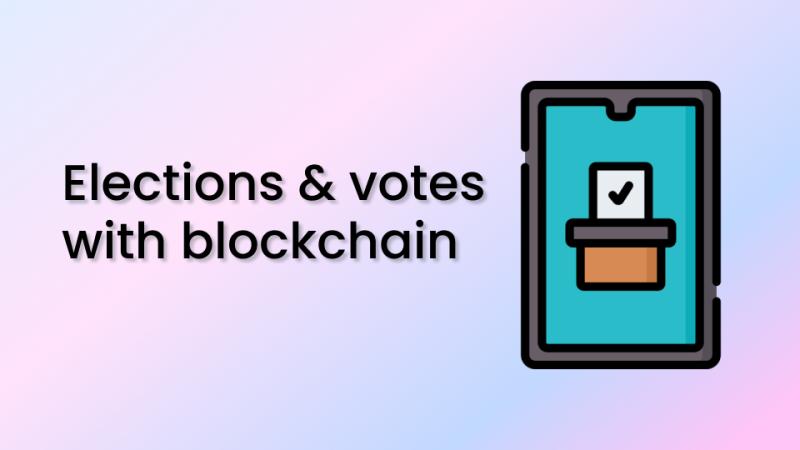How Blockchain Can Help Prevent Voting Frauds in Elections

Introduction
Voting fraud has been a long-standing issue in elections around the world. From stuffing ballot boxes to manipulating voter rolls, the problem of election fraud threatens the integrity of democratic processes and undermines the trust of citizens in their government.
However, a new technology is emerging that has the potential to revolutionize the way we vote and ensure the security and transparency of elections: blockchain.
How blockchain works
Blockchain is a distributed ledger technology that allows multiple parties to record transactions on a single, secure, and tamper-proof database. The technology is most commonly associated with cryptocurrencies, such as Bitcoin, but its potential applications are far-reaching and include everything from supply chain management to voting systems.
At its core, a blockchain is a chain of blocks, where each block contains a list of transactions. These transactions are grouped together and added to the chain in a linear, chronological order. Once a block is added to the chain, the transactions it contains cannot be altered or deleted.
Blockchains use a consensus mechanism to ensure the integrity of the ledger. In a consensus mechanism, a group of nodes, called "validators" or "miners," work together to validate and add new transactions to the blockchain.
The most common consensus mechanism is called "proof of work" where validators compete to solve a complex mathematical problem in order to add a new block to the chain. The first validator to solve the problem is rewarded with a small amount of cryptocurrency, such as Bitcoin.
Once a new block is added to the chain, it is broadcasted to all the nodes in the network. Each node then updates its copy of the blockchain, ensuring that all copies of the blockchain are identical.
Because all copies of the blockchain are identical, it is almost impossible for anyone to manipulate the ledger without being detected. And due to the fact that blockchain is decentralized, there is no single point of failure that could be exploited by bad actors.
It’s also imperative to add that blockchains are transparent, meaning that all transactions are recorded on a public ledger that can be viewed by anyone. This makes it easy for anyone to verify the accuracy of the vote count. Considering all transactions are recorded on the blockchain, it is almost impossible for anyone to manipulate the vote count without being detected.
Blockchain in elections
1) Transparency
In a blockchain-based voting system, all transactions (i.e., votes) are recorded on a public ledger that can be viewed by anyone. This means that it would be almost impossible for anyone to manipulate the vote count without being detected. A more efficient vote counting process comes about, because anyone can access the votes and check for any errors or inconsistencies.
This feature also allows for a more efficient vote recount process, as the votes are recorded on the blockchain and can be easily accessed.
Finally, transparency also helps to increase voter confidence in the election process. By providing transparency into the voting process, citizens can see that their votes are being counted accurately and that the election results are fair. This is crucial for maintaining trust in the election process and ensuring that the outcome is accepted by the majority of citizens.
2) Decentralized
In a centralized voting system, all the voting records are maintained by a central authority or intermediary, who has complete control over the voting process. This central authority or intermediary can easily manipulate the voting records, making it difficult to detect and prevent fraud. This system also leaves a single point of failure, which can be exploited by bad actors.
On the other hand, in a decentralized blockchain-based voting system, all transactions (i.e., votes) are recorded on a distributed ledger that is spread across many different nodes in the network. Each node has a copy of the blockchain, and all copies of the blockchain are identical. This means that it would be almost impossible for anyone to manipulate the vote count without being detected.
So, because blockchain is decentralized, there is no single point of failure that could be exploited by bad actors.
2) Immutability
Immutability is a key feature of blockchain technology that ties into preventing voter fraud. Immutability refers to the ability of a blockchain to ensure that once a block is added to the chain, the transactions it contains cannot be altered or deleted.
In a traditional voting system, vote counting and record-keeping is done manually, and it leaves room for human error and manipulation. Once the votes are cast, the votes are recorded on paper or electronic devices, and the votes are then tallied. There is always a risk that the vote count can be manipulated, either by accident or intentionally, and the records can be changed or lost.
However, by using blockchain technology, the votes are recorded on a distributed ledger that is spread across many different nodes in the network. Once a vote is recorded on the blockchain, it cannot be altered or deleted.
Furthermore, the immutability of blockchain also ensures that the anonymity of the voter is protected. It ensures that the voter's identity is not revealed, as the only information that is recorded on the blockchain is the vote, and not the voter's identity. This is important for protecting voter anonymity and maintaining trust in the election process.
Challenges and limitations
While blockchain technology has the potential to revolutionize the way we vote and ensure the security and transparency of elections, there are also several challenges that must be addressed.
1) Cost
One of the biggest challenges is cost. Setting up and maintaining a blockchain-based voting system can be expensive. This is because blockchain technology is still in its early stages of development and many of the solutions available today are not yet fully mature or cost-efficient.
Additionally, there are also legal and regulatory challenges to overcome, particularly in terms of data privacy and security.
2) Scalability
Another challenge is scalability. While blockchain technology is well-suited to handle a small number of transactions, it is not yet scalable enough to handle the high volume of transactions that would be required for a national election.
This is because the current infrastructure of blockchain networks is not robust enough to handle the large number of transactions that would be needed in a national election. To add to that, there also exist some blockchain solutions that are facing issues with computational power and energy consumption.
3) Lack of understanding and adoption
Another limitation of blockchain technology is that it is not yet fully understood by the general public. This can make it difficult to educate citizens on how to use a blockchain-based voting system and increase the risk of user error. However, this can be solved by blockchain education.
Adding to that, voter anonymity is a key feature that should be preserved in any voting system, and it is still not clear how this can be achieved in a blockchain-based voting system.
4) Hacks and attacks
In terms of security, blockchain is not immune to attacks, and there have been several reported cases of successful attacks on blockchain-based systems. Therefore, it is crucial to have a robust security infrastructure in place to protect against potential attacks and ensure the integrity of the voting process
Real-life uses of blockchain technology in elections
There are already several examples of blockchain being used in voting systems around the world.
In West Virginia USA, for example, blockchain was used in the 2018 midterm elections to allow military personnel serving overseas to vote using their smartphones. The pilot program was considered a success, with 150 military personnel casting their votes via blockchain.
Another example is Moscow's city government, which used blockchain in 2019 to allow citizens to vote on proposed city budgets. The system was designed to increase transparency and public participation in the budget-making process. The results of the vote were recorded on a public blockchain, making it easy for anyone to verify the accuracy of the vote count.
The benefits of using blockchain for voting are many. For one, blockchain can increase security by making it almost impossible for bad actors to manipulate the vote count. Additionally, because all transactions are recorded on a public ledger, blockchain can increase transparency and accountability in the voting process. This can help to build trust in the electoral process and increase public participation.
Conclusion
Blockchain technology has the potential to revolutionize the way we vote and ensure the security and transparency of elections.
From West Virginia to Moscow, we are already seeing examples of how blockchain is being used in voting systems around the world. However, there are also challenges and limitations to using blockchain for voting that must be addressed.
As blockchain technology continues to evolve and more applications are developed, we can expect to see even more secure, transparent, and fair elections in the future.
About the Author:

Sinwan Zahid
Content Lead at Metaschool - the best and most efficient web3 learning OS to elevate the future of the web. Linkedin Profile: https://www.linkedin.com/in/sinwan-zahid/
Previous Posts: